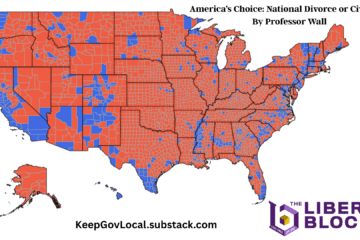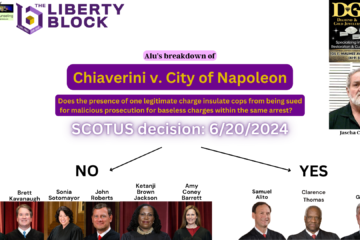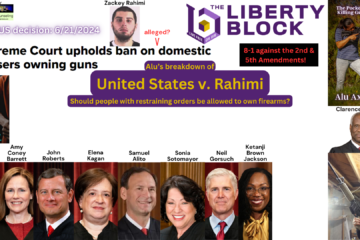By Dennis Pratt for The Liberty Block
A large minority, if not a majority, of Americans are exhausted by the constant bickering, personal destruction, political back-stabbing, and even street violence that has marked the Pyrrhic effort to force 50 disparate states to remain united-in-name-only. They have accepted that many of our differences are personally non-negotiable and thus irreconcilable with people determined to use the violent power of the Federal Government to impose just the opposite on them. Prominent conservatives and even prominent progressives have openly called for “National Divorce”, but how might the unwieldy conglomerate of 50 states separate to best ensure that each political faction lives amongst its own kind?
Libertarians have long believed that peaceful separation is the easy and obvious solution for our severe political disagreements. Let me share with my non-libertarian friends how we might voluntarily choose to restructure into new countries.
Plebiscite
The first idea that most people latch onto is a plebiscite in each of the current 50 states: all citizens in each state would vote directly on a binary choice for which country their state should join:
- “Conservative United States” [CUS] or
- “Progressive United States” [PUS]
While no votes have yet been taken, this process might result in a break-up that could look a bit like this”
(Warning: The color scheme is pre-1992*, with Blue designating the more calm conservative and Red designating the more socialist progressive.)
Most of New England and the Mid-Atlantic would vote “Progressive”, with New Hampshire grudgingly voting “Conservative”. In the Midwest, we’d see at least Minnesota, Wisconsin, and Illinois join the Progressive Faction. The West would have at least Colorado joining the Progressives. The entire West Coast, if they voted as intact states, would join the Progressive union. The South would be hard-pressed to have the majority of any state agreeing to join a Progressive union, but it could be close: votes would probably have to be re-counted in North Carolina and Georgia. Hawaii would most certainly join the Progressives.
Much of the remainder – the South, the ‘Fly-over” States, isolated Alaska – would likely join the new Conservative Faction.
(MI, PA, NC, GA, AZ, NM, NV, NH could swing in either direction.)
This rough cut would alleviate much of the national tensions. The Progressive country would be free to go much further, much faster towards their goal of progressivism, without their progress impeded by conservative states. The Conservative country would be freed to live much more conservatively, without being constantly threatened with Federal Government violence to live like progressives.
But, as you are likely already objecting, while way more people would now be living under a government they much preferred, large swaths of the population within these states would still be stuck under a rulership that is contrary to their political preferences. Inevitably, some of the political battles we currently suffer nationally would shift to the state level, but their intensity would be ratcheted down as the differences would be diminished: Mississippi would no longer by trying to impose its brand of conservatism on Californians, nor New Yorkers trying to impose its brand of progressivism on Wyoming.
Partitioning
The US Constitution offers a process called “partitioning” whereby a state, wracked by political division, can divide itself into two states. What if we supported any state that had such diverse populations within it to partition into more homogeneous political states, and then plebiscite both resultant states to their preferred countries?
Looking only at partitions that have been proposed in the past and that were based on a Left <> Right divide, we might see a partitioned binary separation that looked like this:
In the west, a new conservative state “Jefferson”, partitioned from California and part of Oregon, would be the largest new state. Separating based on the Cascade mountain range, new conservative state “Liberty” would partition from progressive Washington, while new conservative state “Greater Idaho” would partition from the progressive coastal Oregon. New progressive state “Gadson” would partition from Arizona and unify with part of New Mexico. A new conservative state “North Colorado” would partition from a progressive Colorado.
In the Midwest, partitioning the strongly progressive Cook County from the conservative farming southern Illinois would ease divisive political tensions significantly.
In the Northeast, Maine’s large but sparsely populated 2nd Congressional District “Acadia” might partition from the 1st Congressional district. A new, much more progressive state of “New York” – composed of at least NYC, Long Island, and Westchester County – would form by partitioning away from the conservative “Northern New York”. A new progressive state of “Philly” would partition from the much more conservative (Pennsatucky) Pennsylvania. The more conservative western panhandle of Maryland would partition from Maryland (and likely unify almost immediately with West Virginia). The progressive “Northern Virginia” region, bordering DC, has long been at war with conservative RoVA (the Rest of Virginia), and their partition would bring much more peace to that region.
One final partition we might recognize from the legacy proposals for partitioning would be the emergence of a progressive state “Southern Florida”, separating from its conservative rulers in Pensacola.
These partitions would give us a total of 63 (including DC) states. Each resulting state would be far more homogenous, reducing tensions significantly. A plebiscite within each now – over which country to join (Progressive US or Conservative US) – could proceed with much less internal strife, and a much clearer winner.
Not Just Two Choices for Governance
But wait! There’s more we can do to allow each country to actually be “governed with the consent of the governed”.
So far, we have arbitrarily limited the available choice of destination countries to which states could join to
- “Progressive United States” or
- “Conservative United States”
This rough dividing of one gigantic, discordant, can’t-get-along, heterogeneous country into two more homogenous nations does quickly relieve the majority of the tensions, but as long we are going through the trouble of national divorce, why restrict the alternative governances that a state may choose to just two? We can’t possibly know the optimal number of separate countries that states would prefer to form, so why not allow the states to decide organically the number of countries themselves?
Just amongst the “progressive” states, one can readily imagine that differing regional interests might lead to different preferences for governance. Perhaps, if given the freedom to make whatever unions they preferred, the states might form:
- A southwest Pacific progressive union,
- A northwest Pacific progressive union,
- A midwest progressive union, and
- A northeast progressive union.
But proximity does not guarantee similar preferences in governance. For example, in the northeast, Vermont is a state with a strong affinity for democratic socialism. Southern New York, New Jersey, and Philly have quite different approaches to governance than do RI and MA.
Mind you, diversity in governance won’t just be a progressive preference. We should see analogous preferences for regional differences amongst “conservative” states. For example, libertarian New Hampshire is not “conservative” in the way that a Texan would appreciate, and so NH might well align more naturally with a “Live and Let Live” Acadia than it would with southern, religious conservative authoritarian states. Southern conservative states, midwest conservative states, and western conservative states also might prefer to govern quite differently, rather than being governed by far-away states that do not share their region, culture, and interests.
We cannot know the number of distinct countries that might form when states voluntarily agree to form unions together. But certainly, given our wide differences in politics and interests across such a large expanse of land and populations, the number of resultant countries would be more than two.
Continuing Partitions and Unifications
But remember, we only partitioned thirteen new states because we considered only those partitions that had been suggested before the upcoming great #NationalDivorce. Once states start partitioning, more states will want to partition. Any oppressed region, out-of-step with its parent state, would realize that it too can partition to escape its abusive relationship. Progressive cities like Detroit, the Twin Cities, Gary, and Atlanta, and geographic regions like the upper peninsula of Michigan or the southwest border of Texas might decide to partition off. Some of these might join a nearby state, or form with others a new country, or even become its own city-state.
As more counties partitioned from parent states and unified with new states, the map of states would look less and less like it did when all states were force-fit into the ‘Divided State of America’.
But with every voluntarily-chosen partition and every new freely made unification, we would see a far more harmonious North America.
Migration and Partition
Of course, we have only gotten down to the county level partitions, where entire counties leave one state to join another. Within each county, we can assume that there will still be political divisions – certainly not on the national scale we have suffered, but still possibly unbearable for some. This is where migration will help. Encouraging families to move to counties and states that better match their values will decrease the strife within counties. These moves should become shorter and easier, as alternatives proliferate.
We are already seeing massive migrations:
- Of conservatives to Florida and Texas
- Of progressives to Massachusetts, to California, to Washington
- Of conservitarians to Tennessee and to Indiana
- Of socialists to Oregon and to Vermont
- Of libertarians to New Hampshire
As these states form more clearly different governance factions, and the Federal Government leaves them alone to govern themselves, we should see an acceleration of this self-selection into the form of governance each person prefers.
End State
What will the end state be? If humans are free to voluntarily form unions for governance it is safe to say that there will never be an end state, nor should there be. Countries based on some group’s “good idea” will start-up and attract an increasing number of migrants and partitioning counties. Countries with bad ideas will lose migrants, and counties will partition off for better deals.
In this way, we can create a far better world, where governance innovates and evolves to better serve the needs of a changing assortment of segments. Tom Kempf wrote a book that explains how restructuring the union in this way could be the solution to avoiding civil war.
——–
Dennis Pratt was the #1 writer on libertarianism on Quora, a competitive intellectual Q&A site, writing 1800 essays before being deplatformed in 2020. He migrated to New Hampshire and is building liberty communities and organizing liberty events in this one small Free State quickly becoming the Libertarian Homeland. He is a member of NHExit and supported New Hampshire’s recent bill to put in front of NH citizens a referendum on whether to remain subjugated to Washington DC.
This article does not necessarily reflect the opinions of The Liberty Block or any of its members. We welcome all forms of serious feedback and debate.


